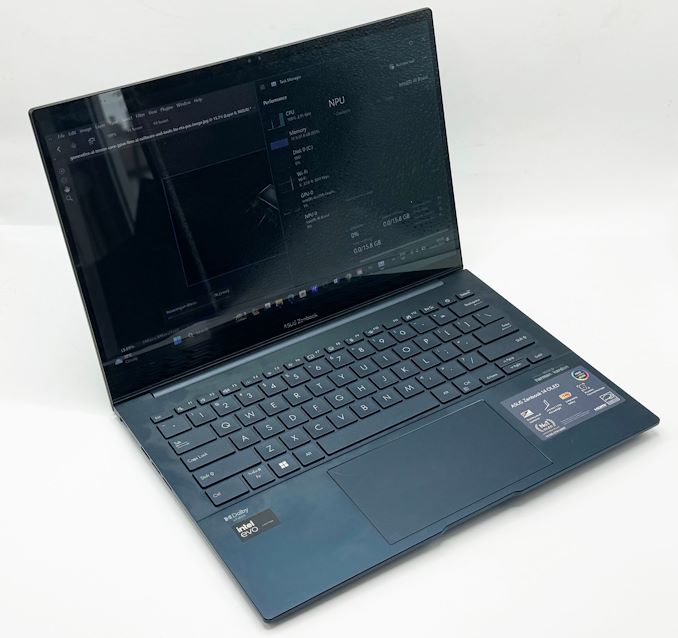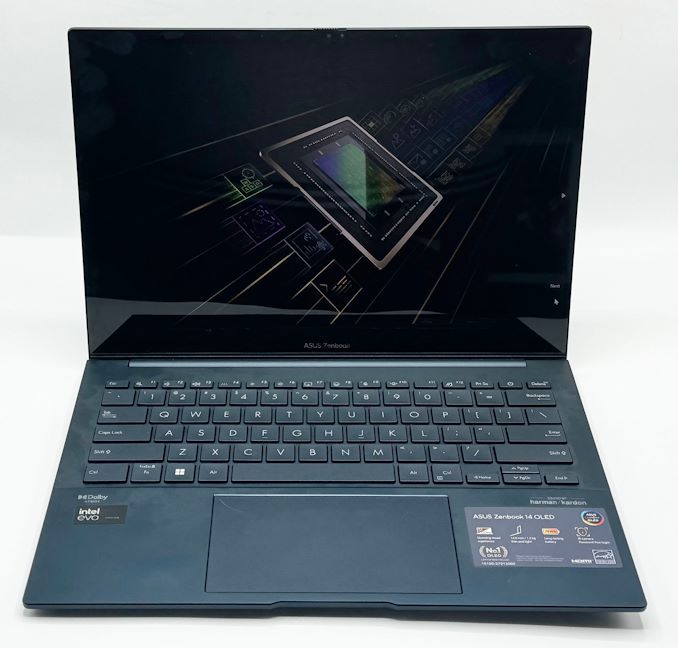The Intel Core Ultra 7 155H Review: Meteor Lake Marks A Fresh Start To Mobile CPUs
by Gavin Bonshor on April 11, 2024 8:30 AM ESTASUS Zenbook 14 OLED UX3405MA: Closer Look
The ASUS Zenbook 14 OLED is one of Intel's EVO-certified notebooks, offering plenty of style and substance within the thin 14.9 mm chassis. While ASUS hasn't provided information on what the chassis is built from, it does look and feel like an aluminum chassis, which doesn't feel particularly cheap and looks the part. As with the rest of the chassis on the ASUS Zenbook 14 OLED, the lid is made from the same aluminium-like material, and it looks very stylish with the Ponder Blue color.
At 312.4 x 220.1 x 14.99 mm (W x D x H), it's portable. The inclusion of the 14-inch 2.8K OLED display and a total weight of just 1.28 kg (2.82 lbs) makes it very capable for its size, as well as a very lightweight offering to travel with. For comparison, the Apple MacBook Air 13-inch (M3) weighs just 0.04 kg less.
Opening up the traditional clamshell design, we can see the 14-inch OLED panel dominating the top half, with the keyboard and the centrally located island-style trackpad. The trackpad doesn't have any discrete buttons, and instead is entirely touch-based. The keyboard keys themselves have a shallow key press and combine the cursor arrows with the (Fn) key functionality while offering a subtle white backlight behind the keyboard, making the Zenbook 14 OLED 'pop.' Although ASUS doesn't include a dedicated fingerprint scanner, along the top of the panel's bezel is a 1080p webcam with a privacy shutter with support for Windows Hello, which can be configured to provide IR face recognition without needing a PIN.
Touching on the display, with a 2.8 K (2800 x 1800) OLED panel, it's fair to say that with the brightness turned up, it's very vibrant and colorful, to say the least. The 14-inch display, according to the official specifications, has a peak brightness of 500 nits when using HDR, while it has a 400 nits peak brightness when HDR is turned off. It can cover 100% of the DCI-P3 color gamut, with a 0.2 ms response time. Regarding refresh rate, the panel supports 120 Hz, while ASUS allows users to switch between either 60 Hz or 120 Hz operation. The panel also has a capacitive touch layer, and ASUS includes a stylus within the packaging for this model.
Looking at the I/O on the ASUS Zenbook 14 OLED, ports and connectors are on both sides of the chassis. Focusing on the left side, it offers a single USB 3.2 G1 Type-A port towards the fold. Three ports look like connectors, but these are just ventilation gaps for airflow to escape.
On the right side are two Thunderbolt 4-capable USB Type-C ports, which support external displays and offer USB power delivery (USB-PD) capabilities. The Zenbook 14 OLED doesn't have a dedicated connector for charging, and instead relies on carging through its USB Type-C ports, with ASUS including a 65 W AC Type-C charger in the box. Also on the right-hand side is a single HDMI 2.1 video output and a single 3.5 mm combo audio jack. ASUS includes a USB Type-A to Ethernet adapter in the box, which I haven't seen for a while.
Overall, from looking at and considering the feel of the ASUS Zenbook 14 OLED UX3405MA, it's certainly a quaint premium 14-inch ultrabook. The bottom-mounted Harmon Kardon linear speakers, which don't look much, sound great and are certainly better than typical stock speakers. There's also the 14-inch OLED screen, which looks great and is vibrant and crystal clear, as expected from an OLED panel.
With a price tag (as configured) of $1299, the ASUS Zenbook 14 OLED UX3405MA is certainly a capable offering, which is powered by Intel's latest Core Ultra 7 155H Meteor Lake SoC, but style and design are one element; performance is perhaps the most important element.
ASUS Zenbook 14 OLED UX3405MA: Software
Before we examine the performance, we'll quickly examine the software bundle supplied. Everything on the ASUS Zenbook 14 OLED revolves around the MyASUS software, which acts as a centralized hub for functionality, profiles, updating drivers/software, and customization.
The MyASUS software has many different device settings that users can customize, such as enabling battery care mode, which limits battery charging beyond 80% immediately. Users can also select between three different fan profiles, including performance mode, which maximizes performance, although this does mean the notebook runs very loud. The other options include standard mode, which dynamically adjusts based on the temperatures, and whisper mode, which is very useful for watching moves in bed.
There are also many display-related options, including allocating more system memory to the integrated Arc Xe graphics and different visual profiles to select from depending on the task. Overall, there are plenty of functionalities within the MyASUS software hub, and having it all within a unified piece of software makes things much better for the overall user experience.


























69 Comments
View All Comments
Gavin Bonshor - Friday, April 12, 2024 - link
I refer to it as a major gain; the other victories weren't huge. That was my point Replysjkpublic@gmail.com - Thursday, April 11, 2024 - link
Comparing the 155H to the 7940HS is apples to oranges. A better comparison would be the 185H. ReplyBigos - Thursday, April 11, 2024 - link
What happened to SPECint rate-N 502.gcc_r results? I do not believe desktop Raptor Lake is 16-40x faster than the mobile CPUs... ReplySarahKerrigan - Thursday, April 11, 2024 - link
No, something is clearly wrong there. I deal with SPEC a lot for work and that's an abnormally low result unless it was actually being run in rate-1 mode (ie, someone forgot to properly set the number of copies.) ReplyGavin Bonshor - Friday, April 12, 2024 - link
I am currently investigating this. Thank you for highlighting it. I have no idea how I missed this. I can only apologize Replymode_13h - Monday, April 15, 2024 - link
While we're talking about SPEC2017 scores, I'd like to add that I really miss the way your reviews used to feature the overall cumulative SPECfp and SPECint scores. It was useful in comparing overall performance, both of the systems included in your review and those from other reviews.To see what I mean, check out the bottom of this page: https://www.anandtech.com/show/17047/the-intel-12t... Reply
Ryan Smith - Monday, April 15, 2024 - link
That's helpful feedback. It's a bit late to add it to this article, but that's definitely something I'll keep in mind for the next one. Thanks! Replymode_13h - Wednesday, April 17, 2024 - link
You're quite welcome!BTW, I assume there's a "standard" way that SPEC computes those cumulative scores. Might want to look up how they do it, if the benchmark doesn't just compute them for you. If you come up with your own way of combining them, your cumulative scores probably won't be comparable to anyone else's. Reply
Ryan Smith - Wednesday, April 17, 2024 - link
"BTW, I assume there's a "standard" way that SPEC computes those cumulative scores."Yes, there is. We don't run all of the SPEC member tests for technical reasons, so there is some added complexity there. Reply
mczak - Thursday, April 11, 2024 - link
Obviously, the cluster topology description is wrong in the core to core latency measturements section, along with the hilarious conclusion the first two E-cores having only 5 ns latency to each other. (First two threads of course belong to a P-core, albeit I have no idea why the core enumeration is apparently 1P-8E-5P-2LPE.) Reply